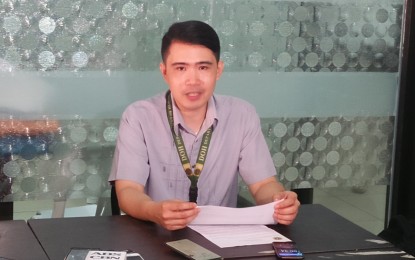
Department of Health Western Visayas Center for Health Development senior health program officer John Richard Lapascua (Photo by Perla Lena)
ILOILO CITY – Cases of coronavirus disease 2019 (Covid-19) in Western Visayas are declining as shown by the negative 74 percent growth rate in the past one to two weeks when compared with the number of cases in the last three to four weeks.
During the virtual press briefing Monday, Department of Health Western Visayas Center for Health Development (DOH WV CHD) senior health program officer John Richard Lapascua said the region’s average daily cases as of February 20 dropped to 452 when compared with 828 cases in January.
The average daily attack rate in the region is low in provinces and highly urbanized cities, except for this city that recorded 11.36, which is considered under moderate risk classification.
“If we sum that up together with the risk classification, the alert level that we recommend is Level 2 in Aklan, Antique, Capiz, Guimaras, Iloilo and Negros Occidental; Level 1 in Bacolod City; and Level 3 for Iloilo City. On the average for the whole region, our alert system is Level 2 as of Feb. 20, 2022,“ he said.
The region’s health care utilization rate as of Sunday was at low risk with 879 or 35.39 percent of the 2,484 beds dedicated to Covid-19 are occupied and 27 of the 185 mechanical ventilators are utilized.
In terms of temporary treatment and monitoring facilities (TTMF) of local government units (LGUs), only 650 out of the 16,363 beds, or 3.98 percent are occupied.
He said the declining cases could be attributed to the observance of minimum public health standards (MPHS), increased awareness on the transmission of the Omicron variant, and movement restrictions since Western Visayas was placed under Alert Level 3 from January 16 until February 20.
Lapascua said that amid the declining cases, they continue to campaign for vaccination, especially for booster shots.
“The booster dose is another layer of protection. It adds to the efficiency or efficacy of our primary series vaccines,” he said.
In its report as of 3 a.m. of February 21, the Regional Vaccination Operations Center (RVOC) said that of the 4,519,101 who were fully vaccinated, only 499,719 or 7.78 percent have booster shots.
Meanwhile, Lapascua said the pediatric vaccination for the 5 to 11 and 12-17 age groups has a “good response”.
The RVOC data showed that 27.55 percent or 24,964 target pediatric 12 to 17 age group with comorbidity and 85.9 percent or equivalent to 700,560 for the rest of the pediatric population (ROPP) of the same age group have their first dose.
For the second dose, 17,904 of the 12-17 age group with comorbidities and 626, 230 for the ROPP have already received their second dose.
For 5 to 11 years old, 26,879 or 2.49 percent of the over 1 million target for Western Visayas availed of their first dose during the first seven days of the rollout.
He attributed the high turnout for the pediatric vaccination to the willingness and acceptance of parents and their children to get inoculated. (PNA)
